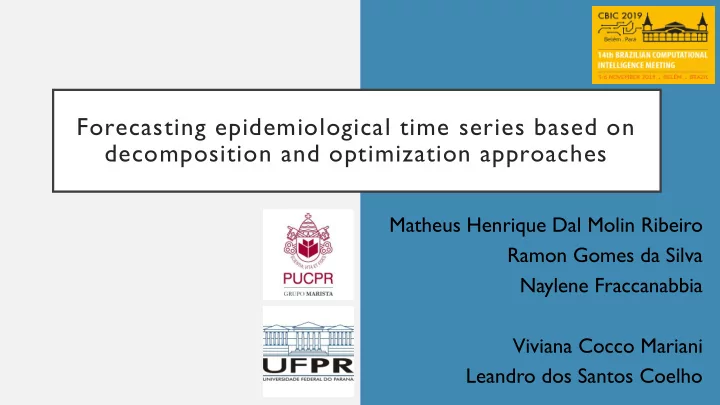

Forecasting epidemiological time series based on decomposition and optimization approaches Matheus Henrique Dal Molin Ribeiro Ramon Gomes da Silva Naylene Fraccanabbia Viviana Cocco Mariani Leandro dos Santos Coelho
Presentation agenda • Introduction • Objectives • Dataset • Methodology • Results • Conclusion 2
Introduction • Meningitis is an inflammation of the meninges, membranes that surround the brain and spinal cord; • In Brazil , meningitis is considered an endemic disease. • In 2018 have 15,000 cases of meningitis and 3,000 resulted in death; • Forecasting meningitis cases allows to develop a strategic planning ; • Due to chaotic behavior , through the hybridization of ensemble, decomposition and optimization approaches is possible to build an efficient forecasting model. https://www.sciencedirect.com/science/article/pii/S2214109X1630064X#fig1 3
Objective • This paper proposes a new hybrid approach that combines Ensemble Empirical Mode Decomposition, Quantile Random Forest based ensemble and Multi-Objective Optimization to forecast Meningitis Cases one-month ahead in • Para (PA) • Parana (PR) • Santa Catarina (SC) 4
Dataset • The data set from DATASUS website; http://tabnet.datasus.gov.br/cgi/deftohtm.exe?sinannet/meningite/bases/meninbrnet.def • Monthly meningitis cases from 2007 to 2018 recorded; 5
Dataset 12 years (monthly measures) Augmented Dickey-Fuller test PA, PR, SC series are non-stationary (DF = -5.35 - -3.41, p-value > 0.05). Seasonality in the data (Kruskal-Wallis test) PA and SC series: there is no evidence of seasonality PR state series : there is evidence of seasonality. 6
Methodology Ensemble Empirical Mode Decomposition (EEMD) Norden E. Huang et al. ( NASA ) HHT (1998, cited by 19636), EEMD (2009, cited by 4857) Hilbert-Huang Transform (HHT) This approach consists of sifting an ensemble of white noise-added signal (data) and treats the mean as the final true result. Empirical Mode Hilbert Spectrum Decomposition In this sense, it is performed the decomposition of (HS) time series signal with objective to extract the (EMD) coexisting oscillatory functions, named IMF (intrinsic mode functions) and residual component, from original data. Ensemble Empirical Mode Decomposition Studies on its properties: (EEMD) decomposing white noise N. E. Huang et al., “The Empirical Mode Decomposition Method and the Hilbert Spectrum for Non - stationary Time Series Analysis,” Proc. Roy. Soc. London , 454A, pp. 903-995, 1998. Z. Wu and N. E. Huang, “Ensemble Empirical Mode Decomposition: A Noise - Assisted Data Analysis Method,” Advances in Adaptive Data 7 Analysis , Volume 1, No. 1, pp. 1-41, 2009.
Methodology Quantile Random Forest (QRF) It provides information about the full conditional distribution of the response variable, not only about the conditional mean. Quantile random forests give a non-parametric and accurate way of estimating conditional quantiles for high-dimensional predictor variables. 8
Methodology Non-Dominated Sorting Genetic Algorithm (NSGA-II) K. Deb, A. Pratap, S. Agarwal, and T. Meyarivan, “A fast and elitist multiobjective genetic algorithm: NSGA- II,” IEEE Transactions on Evolutionary Computation , vol. 6, no. 2, pp. 182-197, 2002. 9 https://ieeexplore.ieee.org/document/996017
Methodology Roadmap of hybrid framework TOPSIS : Technique for Order IMFs : intrinsic Preference by Similarity to Ideal Solution mode functions 10
Methodology 11
Performance measures Methodology Statistical tests • Friedman test and Nemenyi test post-hoc critical difference 12
Results 13
Pareto front Results 14
Performance measures Results 15
Results observed x predicted values 16
Results = − − 2 Friedmann Test = 12.51 14.97, p value 0.05 2 CD = 1.1088, 1.1722 and 1.1722 for PA, PR and SC. PR and PA states EEMD-QRF-MOO shows lower errors than EEMD-QRF but no statisical significant. 17
Conclusion • A hybrid framework combining EEMD, QRF and MOO was proposed; • EEMD was employed to decompose the series, QRF to forecast each obtained component and MOO to find weights for these components; • One-month ahead forecasting the meningitis cases in PA, PR and SC states was studied; • EEMD-QRF-MOO is competitive with 2 cases better than EEMD-QRF and all cases better than QRF model. • Decomposition and optimization allow to enhance models performance; • For future works is intend • Adopt different combinations of models for EEMD components. • Increasing the number of steps ahead to forecasting. 18
Acknowledgments 19
Thank you 20
Comments: HHT, EEMD Fourier STFT Wavelet HHT Basis A priori A priori A priori Adaptive Convolution: Convolution: Convolution: Differentiation: Frequency global, regional, regional, local, certainty uncertainty uncertainty uncertainty Energy- Energy-time- Energy-time- Energy-time- Presentation frequency frequency frequency frequency Nonlinear No No No Yes Nonstationary No Yes Yes Yes Discrete: No Feature No Yes Continuous: Yes Extraction Yes Theoretical Theory Theory Theory Empirical Base complete complete complete 21
Recommend
More recommend